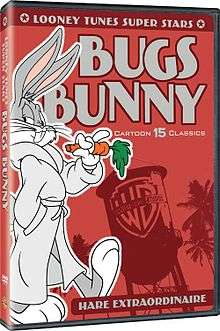Looney Tunes Super Stars' Bugs Bunny: Hare Extraordinaire
| Bugs Bunny: Hare Extraordinaire | |
|---|---|
 DVD-cover | |
| Directed by | Friz Freleng, Robert McKimson, Chuck Jones |
| Produced by | Eddie Selzer, John W. Burton, David H. DePatie |
| Starring | Bugs Bunny, Yosemite Sam, Tasmanian Devil, Granny, Daffy Duck, Marvin the Martian, Mel Blanc (voice) |
| Distributed by | Warner Home Video |
Release dates | August 10, 2010 (United States) |
Running time | 125 minutes |
| Country | United States |
| Language | English |
Looney Tunes Super Stars' Bugs Bunny: Hare Extraordinaire is a DVD of 15 new-to-DVD Bugs Bunny cartoons released on August 10, 2010.[1] Along with Daffy Duck: Frustrated Fowl, these two DVDs are the successor to the Looney Tunes Golden Collection series. None of the cartoons featured in this DVD were previously found on the Golden Collection sets.
Contents
- All cartoons on this disc star Bugs Bunny.
| # | Title | Co-Stars | Release Date | Director | Series |
|---|---|---|---|---|---|
| 1 | Mutiny on the Bunny | Sam | February 11, 1950 | Friz Freleng | LT |
| 2 | Bushy Hare | Hippety Hopper | November 18, 1950 | Robert McKimson | LT |
| 3 | Hare We Go | January 6, 1951 | Robert McKimson | MM | |
| 4 | Foxy by Proxy | February 23, 1952 | Friz Freleng | MM | |
| 5 | Hare Trimmed | Granny, Sam | June 20, 1953 | Friz Freleng | MM |
| 6 | ^Lumber Jack-Rabbit | Charlie | September 26, 1953 | Chuck Jones | LT |
| 7 | ^Napoleon Bunny-Part | Mugsy | June 16, 1956 | Friz Freleng | MM |
| 8 | ^Bedevilled Rabbit | Taz, She-Devil | April 13, 1957 | Robert McKimson | MM |
| 9 | ^Apes of Wrath | Drunken Stork, Grusome Gorilla, Daffy Duck (Cameo) | April 18, 1959 | Friz Freleng | MM |
| 10 | ^From Hare to Heir | Sam | September 3, 1960 | Friz Freleng | MM |
| 11 | ^Lighter Than Hare | Sam | December 17, 1960 | Friz Freleng | MM |
| 12 | ^The Million Hare | Daffy | April 6, 1963 | Robert McKimson | LT |
| 13 | ^Mad as a Mars Hare | Marvin | October 19, 1963 | Chuck Jones | MM |
| 14 | ^Dr. Devil and Mr. Hare | Taz | March 28, 1964 | Robert McKimson | MM |
| 15 | ^False Hare | Big Bad Wold, Wolf Jr., Foghorn Leghorn(Cameo) | July 18, 1964 | Robert McKimson | LT |
(^) - Cropped to widescreen.[2]
Controversies
This was one of two first Looney Tunes Super Stars that released the majority of some of the cartoons from the post-1953 era, but in a 1:85 widescreen format. Warner Bros. has stated the reason for this was because that's how the post-1953 cartoons were shown in theater, which made many collectors upset as cartoons were filmed in Academy full-screened ratio, not widescreen.
References
- ↑ Long Delays for 'Hare Extraordinaire' and 'Frustrated Fowl', tvshowsondvd.com, March 17, 2010
- ↑ WHV Provides VERY Different Shorts Lists for 'Super Stars' DVDs, tvshowsondvd.com, January 12, 2010